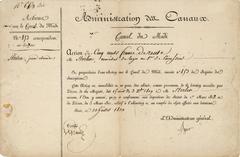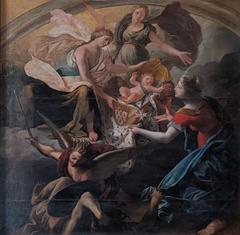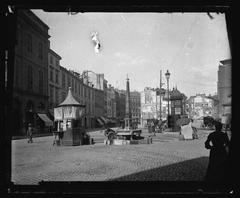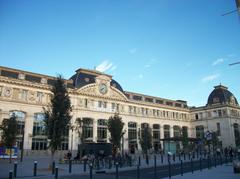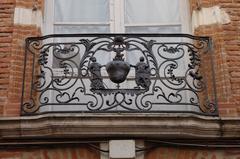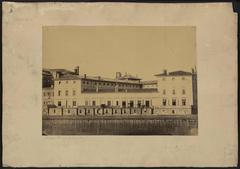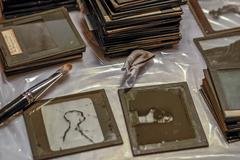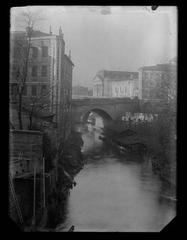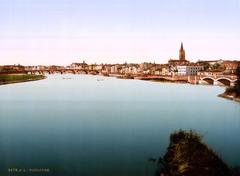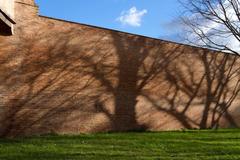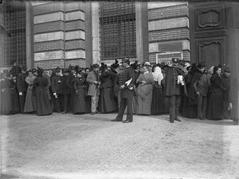Carmes Toulouse, France: Visiting Hours, Tickets, and Historical Sites Guide
Date: 04/07/2025
Introduction
Nestled in the historic heart of Toulouse, the Carmes district is a living tapestry where Roman origins, medieval intrigue, and Renaissance elegance converge with vibrant daily life. Renowned for its distinctive pink brick facades, lively cobbled streets, and an atmosphere steeped in centuries of culture, Carmes invites visitors to immerse themselves in the authentic “Ville Rose” experience. Whether your passion lies in unraveling history, savoring regional cuisine, or discovering artisan boutiques, Carmes offers a multifaceted journey through Toulouse’s past and present.
This comprehensive guide provides everything you need for a seamless and enriching visit—detailed opening hours, ticketing options, accessibility notes, and practical travel tips. You’ll also find insider advice for photography, market experiences, nightlife, and cultural events that animate Carmes throughout the year. With easy access via Toulouse’s efficient metro system and pedestrian-friendly streets, exploring Carmes is both convenient and rewarding.
Prepare to engage with a neighborhood where every corner tells a story, and discover resources like virtual tours and downloadable maps to enhance your adventure. For further details and up-to-date information, consult official tourism platforms and the curated local guides linked throughout this article (French Moments, Lost in Bordeaux, Taste of Toulouse).
Table of Contents
- Introduction
- Historical Evolution and Cultural Significance
- Practical Visitor Information
- Cultural Highlights
- Historic Landmarks and Architectural Highlights
- Cultural Attractions and Artistic Experiences
- Exploring Marché des Carmes: Visiting Hours, Dining, and Gastronomic Culture
- Transportation and Accessibility
- Safety and Etiquette
- Frequently Asked Questions (FAQ)
- Summary and Recommendations
- References
Historical Evolution and Cultural Significance
Roman and Medieval Foundations
The Carmes district traces its origins to ancient Tolosa, founded by the Romans in the 2nd century BC (French Moments). Its present name references the Carmelite monks who established a major convent here in the 13th century, forever shaping the neighborhood’s spiritual and architectural character. The medieval street plan, with its labyrinth of narrow lanes and inviting squares, remains largely intact, offering a tangible link to Toulouse’s earliest days.
Renaissance Prosperity and Architectural Heritage
The 15th and 16th centuries marked Toulouse’s “Pastel Era,” when wealth from the trade in pastel (woad) dye fueled a building boom. Prosperous merchants erected Renaissance townhouses adorned with the city’s signature pink brick, earning Toulouse the nickname “La Ville Rose.” Notable landmarks include the Église de la Dalbade, famed for its remarkable ceramic tympanum (Lost in Bordeaux). The district’s blend of Renaissance, medieval, and neoclassical architecture stands testament to its resilience, having survived events like the Black Plague and the Great Fire of 1463.
19th and 20th Century Transformations
Industrialization brought modernization to Carmes, with new transportation links and urban renewal projects. Despite these changes, Carmes retained its historical character, attracting artists, students, and professionals who continue to enrich its vibrant community (Lost in Bordeaux).
Practical Visitor Information
Key Landmarks and Visiting Hours
- Église de la Dalbade: Open Tuesday–Sunday, 10:00–18:00. Free entry; guided tours available upon request.
- Marché des Carmes (Carmes Market): Open Tuesday–Sunday, 7:00–13:30. Closed Mondays. A hub for fresh regional produce and local delicacies.
- Place de la Trinité: Lively square renowned for cafés and restaurants, best experienced in the evening.
Tickets and Guided Tours
Most Carmes landmarks, including Église de la Dalbade, are free to enter. Guided tours focusing on the district’s history, architecture, and gastronomy can be booked through the Toulouse tourist office or private operators. Advance booking is recommended, especially during peak seasons.
Accessibility
While Carmes’ picturesque, cobbled streets provide undeniable charm, they may challenge those with limited mobility. However, key sites such as Église de la Dalbade and the market are wheelchair accessible. The district is well-served by metro (Carmes station, Line B) and bus lines, ensuring easy access.
Travel Tips and Best Times to Visit
- Market Visits: Early mornings offer the freshest products and the most authentic atmosphere.
- Photography: Late afternoons and early evenings provide ideal lighting for capturing Carmes’ iconic pink facades.
- Seasonal Advice: Spring and autumn offer mild weather and fewer crowds, while summer is lively but can be hot.
Cultural Highlights
Gastronomy and Local Life
Carmes is celebrated for its food culture. At Marché des Carmes, stalls overflow with produce, cheeses, charcuterie, and baked goods. Nearby streets like rue des Filatiers and rue Ozenne are dotted with cafés, patisseries (such as Maison Pillon), and artisanal shops (Lost in Bordeaux).
Artistic and Intellectual Heritage
Carmes’ proximity to the Saint-Etienne Cathedral and Musée du Vieux Toulouse underscores its role as a cultural center (Go Kumquat). The district’s historical ties to the Consistori del Gay Saber highlight a deep-rooted tradition of Occitan literary and artistic culture.
Events and Social Life
The area hosts regular cultural events, including the monthly La Brocante des Allées antique market (Lost in Bordeaux). Nightlife thrives in Carmes, with an array of wine bars, pubs, and music venues.
Historic Landmarks and Architectural Highlights
Place des Carmes
The vibrant Place des Carmes is the neighborhood’s social epicenter, framed by pastel-hued facades and historic buildings. Its daily market (Tuesday–Sunday, 7:00–13:30) is a beloved tradition where locals and visitors mingle (Taste of Toulouse).
Église Saint-Étienne-des-Carmes
A masterpiece blending Gothic and Baroque elements, this church is open daily, 9:00–18:00, with free admission. Occasional guided tours and morning light filtering through stained glass make it a highlight for photographers (Mad Traveller).
Rue des Filatiers and Rue Pharaon
These picturesque arteries, lined with Renaissance and 19th-century architecture, artisan boutiques, and secret courtyards, are particularly photogenic in late afternoon (Toulouse Secret).
Cultural Attractions and Artistic Experiences
Artisan Boutiques and Galleries
Carmes is a haven for creativity, with numerous independent workshops and galleries. Browse unique jewelry, ceramics, textiles, and art—often meeting artists in their studios (Souvenirs Ideas).
Culinary Experiences
- Marché des Carmes: The covered market is an institution for regional delicacies and lively eating spots (Taste of Toulouse).
- Restaurants and Cafés: Discover Occitan bistros, modern wine bars, and vegan cafés. La Cour de l’Archevêque is known for its cassoulet and courtyard setting (Mad Traveller).
- Specialty Shops: Don’t miss Maison de la Violette for the city’s signature violet sweets (Souvenirs Ideas).
Local Experiences and Hidden Gems
Get lost in Carmes’ narrow streets, discovering hidden courtyards, fountains, and murals (Mad Traveller). Shop for handwoven textiles and designer goods, and unwind at terrace cafés or historic bars like Au Père Louis (Taste of Toulouse).
Events and Festivals
Enjoy open-air concerts, art fairs, and food festivals—especially during the summer and the annual Toulouse Festival in July (Toulouse Secret).
Exploring Marché des Carmes: Visiting Hours, Dining, and Gastronomic Culture
Market Overview
The Marché des Carmes is a covered market dating to 1905, located on Place des Carmes. Open Tuesday–Sunday, 7:00–13:30, it offers a wide range of produce, cheeses, charcuterie, seafood, meats, and artisan breads. Local specialties such as saucisse de Toulouse, foie gras, rillettes d’oie, and chocolatine are staples (Toulouse Gourmet Tours).
Market Culture
Marché des Carmes is more than a shopping destination—it’s a social hub where locals swap recipes and enjoy live music during “nocturnes” (Thursday evening events) (Toulouse Secret). Food tours often include tastings here, providing a deep dive into local culinary traditions.
Dining Options
- La Braisière (42 Rue Pharaon): Traditional French cuisine with market-sourced ingredients (Lost in Bordeaux).
- Le Roll: Gourmet sandwiches with locally sourced fillings (Toulouse Secret).
- La brûlerie des filatiers: Specialty coffee.
- L’épicerie apéritive: Aperitifs, charcuterie, and wines.
For desserts, Mr Madeleine specializes in classic and seasonal madeleines. Nearby, LE SEPT (Michelin-starred, 11 Rue Théodore Ozenne) offers contemporary tasting menus with a southwestern French twist (Toulouse Secret Michelin Guide).
Regional Specialties
Expect to find cassoulet, saucisse de Toulouse, foie gras, rillettes d’oie, and chocolatine, alongside cheeses and Occitanie wines (Lost in Bordeaux).
Visitor Tips
- Saturdays are lively; weekdays are more relaxed.
- Many stalls accept cards, but some cash is useful.
- Assemble a picnic from market finds to enjoy in local parks or along the Garonne.
- Book Michelin-starred restaurants in advance.
- Join food tours for insider experiences (Toulouse Gourmet Tours).
Transportation and Accessibility
Metro and Public Transit
Carmes is centrally located and highly accessible via the Carmes Metro Station (Line B), which features elevators, step-free access, and bilingual signage (Metro Toulouse). Tickets can be purchased at machines or via the Tisséo app.
Cycling and Walking
The neighborhood is part of Toulouse’s bike-sharing system, VélôToulouse, with nearby docking stations and extensive cycle paths (Taste of Toulouse). Carmes’ compact size and pedestrian-friendly layout make it ideal for walking.
Car Access
Driving is possible but not recommended due to narrow streets and limited parking. Park-and-ride facilities on the city’s outskirts offer a convenient alternative (Toulouse Tourisme).
Accessibility Features
Most metro stations, buses, and public buildings in Carmes are accessible to wheelchair users, with tactile paving and accessible restrooms (Toulouse Tourisme).
Safety and Etiquette
General Safety
Carmes and Toulouse are generally safe, but be mindful of pickpocketing in crowded spots and on public transport (Vigilios). At night, stick to well-lit, central areas.
Public Transport and Road Safety
Public transportation is reliable; always keep an eye on your belongings. Cyclists should use dedicated lanes (Vigilios).
Emergency Services
Dial 112 for emergencies. Pharmacies and hospitals are widely available.
Cultural Etiquette
A polite “bonjour” when entering shops and “au revoir” when leaving is customary. Toulouse is LGBTQ+ friendly and welcoming to solo female travelers (Vigilios).
Frequently Asked Questions (FAQ)
Q: What are the visiting hours for Carmes Market?
A: Tuesday to Sunday, 7:00–13:30; closed Mondays.
Q: Is there an entrance fee for Carmes landmarks?
A: Most sites, including Église de la Dalbade and Carmes Market, are free to enter.
Q: How can I buy metro tickets?
A: Purchase tickets at station machines or through the Tisséo mobile app.
Q: Are guided tours available?
A: Yes, bookable via the Toulouse tourist office and private operators.
Q: Is Carmes accessible for wheelchair users?
A: Yes, key attractions and the metro station are equipped with accessibility features.
Q: When is the best time to visit Carmes?
A: Spring and autumn for mild weather; early mornings or late afternoons for markets and photography.
Summary and Recommendations
Carmes is the beating heart of Toulouse’s history and culture. Its Roman roots, Renaissance beauty, and lively markets create a dynamic setting for every traveler—history buffs, food lovers, and art enthusiasts alike. With excellent public transport, accessible landmarks, and a welcoming community, Carmes is an ideal base for exploring Toulouse. Utilize digital tools like the Audiala app for guided tours and local insights, and embrace the district’s rich blend of old and new (Toulouse Secret, Toulouse Gourmet Tours, Metro Toulouse).
References
- French Moments, 2025, History of Toulouse (https://frenchmoments.eu/toulouse-history/)
- Lost in Bordeaux, 2025, A Detailed Guide to a Weekend in Toulouse (https://www.lostinbordeaux.com/a-detailed-guide-to-a-weekend-in-toulouse/)
- Lost in Bordeaux, 2025, The Best Areas to Stay in Toulouse: The Districts Guide (https://www.lostinbordeaux.com/the-best-areas-to-stay-in-toulouse-the-districts-guide/)
- Taste of Toulouse, 2025, Top Tourist Attractions & Things to Do in Toulouse (https://www.tasteoftoulouse.com/top-tourist-attractions-things-to-do-in-toulouse/)
- Mad Traveller, 2025, Hidden Gems in Toulouse (https://mad-traveller.com/posts/hidden-gems-in-toulouse/)
- Toulouse Secret, 2025, Secret Guides and Things to Do in Toulouse (https://toulousesecret.com/en/secret-guides/)
- Souvenirs Ideas, 2025, The Best Souvenirs to Buy in Toulouse Plus Shopping Tips (https://souvenirsideas.com/2025/05/05/the-best-souvenirs-to-buy-in-toulouse-plus-shopping-tips/)
- Toulouse Gourmet Tours, 2025, Where to Eat Out in Toulouse (https://www.toulousegourmettours.com/blog/where-to-eat-out-in-toulouse-an-exquisite-journey-to-toulouses-covered-markets)
- Tourist Platform, 2025, Toulouse’s Traditional Markets (https://www.touristplatform.com/article/toulouses-traditional-markets-victor-hugo-market-and-carmes-market)
- Metro Toulouse, 2025, Carmes Metro Station (https://metrotoulouse.com/en/cames-metro-station)
- Travel Vagabonds, 2025, How to Get Around Toulouse (https://travelvagabonds.com/toulouse-packing-list)
- Toulouse Tourisme, 2025, Getting Around Toulouse (https://www.toulouse-tourisme.com/en/prepare-for-your-stay/getting-around-toulouse/)
- Vigilios, 2025, Safety in Toulouse (https://www.vigilios.com/destinations/france/toulouse)
- Travelsafe Abroad, 2025, Travel Safety in Toulouse (https://www.travelsafe-abroad.com/france/toulouse/)
- France.fr, 2025, Destination Toulouse (https://www.france.fr/en/destination/toulouse/)

